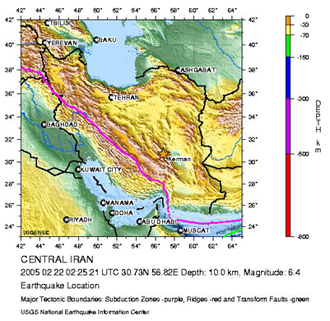 A magnitude-6.4 earthquake struck central
Iran early on the morning of Feb. 22, killing almost 400 people, injuring many
more and devastating the mountainous region.
A magnitude-6.4 earthquake struck central
Iran early on the morning of Feb. 22, killing almost 400 people, injuring many
more and devastating the mountainous region.
 A magnitude-6.4 earthquake struck central
Iran early on the morning of Feb. 22, killing almost 400 people, injuring many
more and devastating the mountainous region.
A magnitude-6.4 earthquake struck central
Iran early on the morning of Feb. 22, killing almost 400 people, injuring many
more and devastating the mountainous region.
The quake occurred at 5:55 am local time, centered outside of Zarand, a town
of approximately 15,000 people in the Kerman province about 600 miles southeast
of Tehran, Iran's capital city, according to the National Earthquake Information Center (NEIC) of the U.S. Geological Survey.
Iran's central mountainous region was
rattled by a 6.4-magnitude earthquake early Tuesday morning. The epicenter was
located 35 miles northwest of Kerman and 600 miles from the capital of Tehran.
Image courtesy of NEIC.
The official death toll continues to grow, but according to an Associated
Press report, 420 people have been found dead and 1,000 had been reported
injured. However, the latest reports from Reuters said
that the earthquake will affect more than 80,000 people because of a lack of
shelter in the cold, mountainous region. The larger cities and concrete buildings
appear to have fared better than the mud brick homes of the rural areas, which
may also have been due to the tremor's depth, reported at an estimated 26 miles,
according to NEIC.
Iran is one of the most earthquake-prone areas in the world, says Waverly Person
of NEIC, because of the interaction between the Arabian and Eurasian plates,
which move approximately 1 inch per year on average. This particular tremor
is not as devastating as the December
2003 Bam earthquake, which was recorded at magnitude-6.7 and occurred only
six miles belowground, but "structures are built very poorly, so it doesn't
take a lot of force to bring them down, killing a lot of people," Person
says.
At this point, Iran has not requested international assistance, says Lou Fintor
of the U.S. Department of State, but the United States "would be prepared
to provide help if need be," he says.
Laura Stafford
Links:
National
Earthquake Information Center
Reuters
coverage
Associated
Press coverage
"Unnecessary
devastation in Iran," Geotimes, December 2003
Back to top
 |
Geotimes Home | AGI Home | Information Services | Geoscience Education | Public Policy | Programs | Publications | Careers |